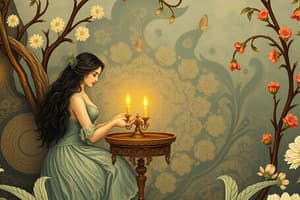Podcast
Questions and Answers
What does the act of creation in art primarily involve?
What does the act of creation in art primarily involve?
Which of the following reflects the values and attitudes of society at a given time?
Which of the following reflects the values and attitudes of society at a given time?
What is indicated by the term 'aesthetic value' in art?
What is indicated by the term 'aesthetic value' in art?
How is beauty described in the context of art?
How is beauty described in the context of art?
Signup and view all the answers
In what way does art serve as a communication tool?
In what way does art serve as a communication tool?
Signup and view all the answers
Study Notes
Art is Everywhere
- Art has existed since the dawn of humanity, present in all societies throughout history.
- It manifests in various forms, reflecting diverse cultural contexts and generational values.
Art as an Expression and Communication
- Art arises from a fundamental human need for self-expression.
- Each period's artwork reveals:
- The intellect and creativity of its artist.
- The societal values and attitudes prevalent during its creation.
Art as Creation
- The term "art" originates from "ars" meaning "skill" in Latin and “techne” meaning proficiency in Greek.
- Creation involves the innovative rearrangement of existing materials to form something new.
- Artistic creation is an ongoing process of refinement and adjustments.
- Art aims to engage the senses and elicit a fulfilling experience of beauty, emphasizing its aesthetic value.
Art and Experience
- Artistic endeavors evoke three core experiences:
- The emotion the artist intends to convey.
- The act of expressing that emotion through the artwork.
- A sense of achieving satisfaction from the creative process.
- The appreciation of art is subjective and deeply personal, incorporating both emotional and intellectual elements.
Art and Nature
- Nature itself is distinct from art; artwork is inherently a product of human effort.
- While art is intentional and structured, nature serves as a consistent inspiration for artistic expression.
- Art has the potential to enhance and improve natural environments.
Art and Beauty
- Beauty is characterized as something pleasurable to perceive.
- The Greek term "aesthetic" encapsulates the concept of sensory perception.
- Definitions of beauty are subjective, influenced by cultural, temporal, and contextual factors.
- Understandings of beauty evolve, varying across periods and cultures.
In Retrospect
- Art's omnipresence underscores its significance in human experience and communication.
- It serves as a powerful tool for personal expression, creative innovation, and exploration of beauty.
- The interplay between art, nature, and individual experience contributes to its enduring relevance and impact.
Studying That Suits You
Use AI to generate personalized quizzes and flashcards to suit your learning preferences.
Description
Explore the fundamental aspects of art as a universal expression throughout history. This quiz delves into how art reflects societal values and the creative process behind artistic creation. Understand the emotional and aesthetic experiences art evokes and its significance in human culture.




